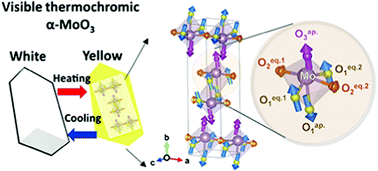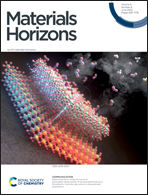Cooperative coupling of anisotropic phonon modes intensifies visible thermochromism in layered α-MoO3†
Abstract
Applications that provide versatile, high temperature warnings require the development of thermochromic materials based on solid-state oxides. To boost the visible thermochromic properties, a fundamental approach to reveal the unclear roles of local structure on band structure modulation should be considered by scrutinizing the thermal motion of phonon modes. Herein, we demonstrate that selective coupling of intra-layer phonon modes intensifies the visible thermochromism of layered oxides α-MoO3. As a result of thermally induced band gap reduction in α-MoO3, the observed color reversibly changes from white at 25 °C to yellow at 300 °C owing to a red shift of the absorption edge with an increase of temperature. This high-temperature thermochromism is attributed to the anisotropic change of layered α-MoO3 crystal structures characterized by synchrotron X-ray diffraction. Notably, quantitative characterizations combined with theoretical calculations reveal that the cooperative coupling of active Raman modes in intra-layer [MoO6] octahedra are responsible for the band gap reduction at high temperature; this defies the general belief regarding the origin of visible thermochromism in layered oxides as the modulation of a van der Waals inter-layer distance. These original results can aid the development of a new strategy to further intensify high-temperature thermochromism by anion doping for highly sensitive temperature-indicating applications.



 Please wait while we load your content...
Please wait while we load your content...